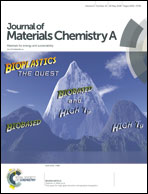Infiltrated mesoporous oxygen electrodes for high temperature co-electrolysis of H2O and CO2 in solid oxide electrolysis cells
Abstract
In the last few years, high temperature solid oxide electrolysis cells (SOECs) have emerged as a promising solution for energy conversion and storage. However, state-of-the-art systems suffer from technological limitations, which prevent their widespread use and market penetration. Particularly, the electrode–electrolyte interface represents a critical element due to the high oxygen potential located in this area, which in turn determines interface delamination. In this context, the use of mesoporous materials, whose architecture is characterized by concatenated nanometric-size pores and high specific surface area, represents a powerful strategy toward the achievement of long-term stability of the electrode. Such structures have been recently proposed as ionically conducting electrode scaffolds for solid oxide fuel cells (SOFCs), exhibiting good performances and low degradation rates. In particular, it has been shown that a highly increased triple phase boundary (TPB)-active points distribution along the electrode may be achieved upon infiltration with a catalytically active material. In this study, infiltrated mesoporous cerium was used as a functional oxygen electrode layer in a fuel electrode supported SOEC system. The results indicate that an enhancement in both long-term stability and electrolysis cell performance are achieved. This is attributed to the decrease in high current density paths and areas of high oxygen potential and to the superior thermal stability of such a nanostructured composite, which allows better current distribution. First, the morphological characterization of the as-synthesized mesoporous Ce0.8Gd0.2O1.9 (CGO), which was carried out by TEM microscopy and low-angle X-ray diffraction (LA-XRD), is presented. A structural and functional investigation of the fuel electrode supported cells, in which the oxygen electrode is composed of catalytically active La0.6Sr0.4Co0.2Fe0.8O3 (LSCF) infiltrating a CGO scaffold, was studied by means of XRD, scanning electron microscopy and spectroscopy, and electrochemical measurements. Characterization under co-electrolysis mode (45% H2O, 45% CO2 and 10% H2) shows an injected current density higher than 1.2 A cm−2 at 1.4 V at 750 °C. Electrochemical impedance spectroscopy was carried out at regular time intervals during galvanostatic (0.5 and 0.75 A cm−2) long-term operation for 1400 h, exhibiting a decrease in polarization resistance and only slight increase in serial resistance during operation. Total degradation rates lower than 2% kh−1 at 0.5 A cm−2 and 1% kh−1 at 0.75 A cm−2 were obtained. Finally, a mechanism for cell degradation based on evolution of the fuel electrode is proposed.



 Please wait while we load your content...
Please wait while we load your content...